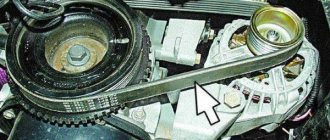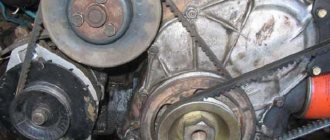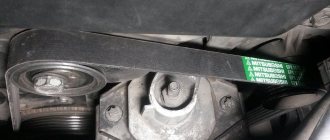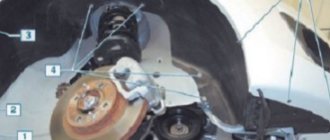Waxing the body or pouring magic additives into the oil or fuel tank does not mean taking care of the condition of your car. Wax and additives can be not only not useful, but also harmful, and in the case of domestic front-wheel drive VAZs, it is much more useful to check the condition of the brakes and engine before each trip. However, there is one thing that is often forgotten and then regretted. This is the drive belt of the VAZ-2114 generator. Let's take a closer look at it.
Installation diagram and purpose of the VAZ 2114 alternator belt
Since the engine installation on the VAZ 2114 is transverse, the VAZ 2114 alternator belt is accordingly located on the right side of the car or on the left side of the engine, if you look at it with the hood open from the cooling radiator side.
At the end of the crankshaft opposite the flywheel there is a timing belt drive pulley, which spins the camshaft and oil pump shafts with a pump, as well as the electric generator drive pulley. The timing drive is covered by a plastic cover, and the belt drive runs outside, on top of this cover, and connects the electric generator drive pulley on the crankshaft to the alternator pulley. On the VAZ 2114 there is no belt tensioner pulley, like on the VAZ 2110. Tensioning the generator belt is done in a different way.
The belt drive is marked 21082-3701720 and when choosing, you need to look for a belt with a length of 698 mm. During operation of the machine, this drive is exposed to serious loads, not only mechanical, but also thermal and chemical. Therefore, high demands must be placed on the quality of the belt drive. Many experts and car enthusiasts recommend using BOSCH or GATES brand belts. And although they cost about 500 - 550 rubles, versus 200 - 300 rubles for products from a Russian manufacturer, the quality of these drives is much higher.
LAYOUT
On this car, however, as on the VAZ 2113 and VAZ 2115 models, the power unit is located across the body. With this engine arrangement, if you open the engine compartment hood, the generator set will be located on the left side of the engine.
On this side of the engine, the timing gear drive pulleys, water and oil pumps are also installed. This drive is covered with a plastic cover, and the generator drive passes over it. The belt installation diagram is shown in the figure.
Alternator belt installation diagram
The figure shows the generator drive parts:
- Bracket for attaching to the engine block;
- Connection of the generator with the bracket;
- Tension screw;
- Generator set pulley;
- Axial screw;
- Drive belt;
- Generator pulley on the crankshaft.
The red arrow indicates the place to check the deflection of the belt drive, and the letter “A” shows its value. If the tension of the generator belt is done correctly, then the bending at the point being checked should not be more than 10 mm, under a load of 10 kg.
Possible malfunctions in the electric generator drive and ways to eliminate them
Malfunctions in the belt drive of an electric generator during operation can manifest themselves in different ways:
- it may be a whistle from the drive location;
- This is a weak generator voltage, due to weak tension and periodic slippage of the belt drive. Slippage can also occur with normal, standard belt tension due to water, coolant or oil getting into the working elements of the drive;
- No less dangerous for the engine is too much tension in the drive. Due to excessively large loads, bearings may be destroyed (how to change a bearing on a VAZ 2114 generator?), gears or shafts damaged, and the belt may also break. In this case, further movement will be impossible until it is replaced with a new, working one. The worst situation is when a gust occurs on the highway, in a deserted place. Driver practice suggests that this does not happen very rarely.
Attention! Experts and experienced car owners recommend having a new belt in a spare set in the trunk, despite the fact that the driver can learn how to properly tension the alternator belt on a VAZ 2114 within 10 minutes. They also advise you to read an article about how to remove the alternator belt in order to be “savvy” for all occasions.
Since the condition of the generator belt drive is a vital issue, monitoring it is the responsibility of the driver. Checking the belt is quite simple - you just need to simply press it with a force of 10 kg to check the deflection. For an electric generator of brand 9402.3701 it should be within 0.6 - 0.9 cm, for brand 37.3701 - 1.0 - 1.5 cm. In addition, it is necessary to check the cleanliness of all drive elements.
If the driver hears that the generator belt is whistling, then it is imperative to immediately check the condition of the belt drive. The fact is that if the belt is really loose, it can twist and break at high speeds.
If during inspection it is determined that there is a weakening, then you need to tighten the generator belt. To do this, you need to perform a number of simple steps and keys to “10” and “13”.
- Place the car on a level surface and put it on speed and handbrake.
- Open the hood and before tightening the alternator belt on the VAZ 2114, use a key set to “13” to loosen the nut securing the alternator housing to the adjusting rail.
Loosening the lower bolt of the VAZ 2114 generator
- Using a “10” key, tighten the adjusting screw of the tensioner mechanism, while the body of the electric generator should move along the rail towards the front of the machine.
- As the tensioner screw rotates, it is necessary to control the belt deflection. After it is within the normal range for the type of electric generator installed on the machine, you need to use a “13” key to firmly tighten the nut on the adjusting rail.
- As soon as the fastening nut is tightened, you need to turn the crankshaft twice by hand and check the deflection again. If it is within the normal range, then, after starting the engine, you need to check the operation of the belt drive in operating mode. During this check there should be no extraneous noise, the belt should rotate without bending or moving to the side.
The replacement procedure is as follows:
- 1. Place the car on the handbrake;
- 2. Put in fourth or third gear;
- 3. Unscrew the three bolts and remove the timing cover;
- 4. Turn the crankshaft counterclockwise and remove the generator drive belt;
- 5. Put the gear in neutral;
- 6. Rotate the crankshaft clockwise and observe the marks and flywheel. When the mark is parallel to the scale division, stop rotating;
- 7. Loosen the tension roller nut. If the roller wears out, replace it;
- 8. Release the tension on the strap using the tension roller;
- 9. Pull a new belt onto the crankshaft pulley;
- 10. Pull the product onto the camshaft pulley so that there is no sagging;
- 11. Rotate the crankshaft and if the marked marks do not match, reinstall the belt;
- 12. Unscrew the crankshaft mount and install the generator pulley;
- 13. Adjust the product by turning the roller counterclockwise. Install the alternator belt.
At the end of the work with the engine running, you need to determine the belt tension by the noise level.
If necessary, replacing the VAZ 2114 timing belt is done with your own hands without the help of specialists. There is nothing complicated in this operation, you just need to follow the instructions.
The timing belt is an important element in a car engine, so you shouldn’t ignore it. This element needs to be checked every 15 thousand kilometers, and replaced every 60 thousand.
Sources
- https://ladaautos.ru/vaz-2114/instrukciya-po-zamene-grm-remnya-na-vaz-2114-8-klapanov-svoimi-rukami-video.html
- https://carfrance.ru/probuem-zamenit-remen-grm-na-8-klapannom-xetchbeke-2114/
- https://vashalada.ru/mashiny/vaz-2114/zamena-remnya-grm-na-vaz-2114-podrobnaya-instrukciya-s-foto-i-video.html
How to tension the alternator belt?
Tensioning the alternator belt is not a difficult task. This operation will take at most 10 minutes. I should immediately note that the VAZ 2114, 2113, 2115 have different engines (1.5 and 1.6 liters), therefore the process of tensioning the belt is different.
For engine 2111 (1.5 l)
- Loosen the tightening of the upper and lower fastenings of the generator.
- We adjust the belt tension using the adjusting screw. Clockwise we tighten the belt, counterclockwise we loosen it.
- Having tensioned to the required point, tighten the generator fastenings and check the belt.
For 1.6L engine
In this operation, in addition to the keys, we will need a small crowbar.
- We also loosen both generator mounts.
- Next, take a crowbar and move the generator away from the engine (pull the belt), resting the crowbar on the cylinder block. If the belt tension needs to be relaxed, then we move the generator towards the engine.
- We tighten the generator mounts and check the belt tension.
If, after adjusting the belt, the problem of voltage sags remains, then look for another problem here, having first checked the generator (How to check the generator?).
Source
How to change it yourself?
How to tighten the timing belt on a VAZ
You can replace the belt on an 8-valve VAZ 2114 with an injector engine yourself or by ordering the appropriate service at a service station. During the shift process, there are nuances that must be taken into account when performing the task. If you make mistakes and do not change the strap correctly, this can lead to rapid wear and breakage. Below are instructions for replacing the belt in a VAZ 2114 8 valve.
Tools
If you change the belt yourself, prepare the following:
- a set of open-end wrenches, you will need tools for 13 and 17;
- long flat blade screwdriver;
- 10mm ring wrench, you can use a ratchet head;
- key for installing the tension roller;
- wheel wrench;
- jack.
User Pro Remont shared a video that describes in detail the procedure for replacing the timing belt pulley and timing belt in a VAZ 2114 car.
Algorithm of actions
How to change a belt correctly:
- Drive the car into a garage with a pit. The surface on which work is performed must be level. Switch the gear selector to neutral position.
- Loosen the bolts on the front right wheel. Place this part of the car on a jack so that the wheel can be rotated.
- Open the hood of the car. Using a 10mm wrench, remove the three screws that secure the plastic strap protector.
- Using a 13mm wrench, you need to loosen the bolt that secures the tension roller. Remove the device.
- You can see a mark on the camshaft gear; it is made in the form of a rectangular protrusion on the edge. When performing work, it is necessary that this mark coincides with the protrusion located on the fastening of the strap casing. If these marks do not match, you need to turn the wheel until they match.
- Then find the rubberized plug installed on the top of the clutch housing; it is located to the right of the power unit’s BC. The part is carefully pryed off with a screwdriver and removed from the seat. Under the plug you can see the flywheel crown; there is a mark on this device. It should be opposite the triangular protrusion located on the left. If the marks do not match, then take a 17mm wrench and loosen the tensioner. Using a pulley removal wrench, turn the device counterclockwise to loosen the timing belt.
- When the upper part of the belt is removed from the gear assembly, take a 17mm wrench and turn the crankshaft until the flywheel marks are opposite each other. The flywheel itself must be secured in this position; to secure it, use a screwdriver and install it between the teeth. If you have an assistant, ask him to hold the tool to prevent it from turning.
- Now you can remove the right wheel. Unscrew the screws that secure the arch protection and dismantle it.
- Using a 17 mm wrench, unscrew the nut securing the generator set pulley. When unscrewing, make sure that the flywheel does not turn.
- Dismantle the generator pulley and remove it from its seat.
- Remove the timing belt from the crankshaft disc.
- Using a 17mm wrench, completely unscrew the tensioner pulley lock and remove it from its seat. If you loosen the fastening, the belt can be removed.
- Install the new product onto the crankshaft disc. When installing, make sure that the marks are not broken. Install the generator set drive pulley by first placing a strap on it.
- Place the product on the gear of the mechanism. Install the tension roller.
- The strap is being installed. During installation, the tension roller must be turned with a special tool purchased in advance at the store. If you don't have one, you can use two self-tapping screws and a screwdriver. Self-tapping screws are installed in the grooves, and a screwdriver secures them. Turning is done counterclockwise. Tension the belt using the tension roller and tighten the screw that secures the roller.
- It is necessary to set marks if they are lost during the work process. The installation procedure for all components is performed in reverse order.
Photo gallery
Photos of belt replacement are shown below.
Unscrew the screws securing the timing belt protective casing. The mark on the camshaft gear should coincide with the mark on the casing fastening. Loosen the belt tension roller by turning it counterclockwise. Remove the belt from the pulleys and install a new product. Unscrew the nut securing the generator shaft. Put on the new belt and tighten the roller.
Alternator belt problems
The most common sign of a malfunctioning alternator belt is its whistling.
There may be several reasons for this phenomenon, the most likely of which are:
- Weak tension. This causes the belt to slip during movement, producing corresponding sounds. Moreover, the intensity of the latter clearly increases at night - after all, the generator in this case works not only for the usual “24-hour” consumers, but also for lighting.
- Belt failure. Long-term use of the generator belt causes natural aging, which negatively affects its structure - cracks form on the surface, and some parts of it may even crumble. In this case, the belt may slip and not transmit the required torque to the generator pulley. The only way out of this situation is to replace it.
- Belt gets wet. Although this happens extremely rarely due to the design and location of the generator drive, when water gets on the surface of the belt, it can also slip due to reduced friction of the working surface.
- Generator jammed. If the generator breaks down, it may jam, causing the belt to slip. In this case, it is not the belt that needs to be repaired, but the generator itself.
Problems with the VAZ 2114 alternator belt
In order to avoid problems with the generator belt, you should periodically (every 1-2 months) check its tension, and also inspect the outer surface for defects.
If during operation of the car it turns out that the belt is in good condition, but at the same time whistles during operation, it is enough to simply tension it.
Why does the whistle occur?
There are several reasons why the characteristic whistle-like sound occurs.
- Weak tension. The element slips, and this happens most actively at night. The increased intensity of the whistle at night is explained by the fact that the generator additionally works for lighting.
- Gradually the component is destroyed. The belt can dry out, causing its structure to be disrupted and it literally crumbles into pieces. The first signs are cracks, and then whole pieces break off. When moving, the pulley hits and slipping begins. Only replacement is required here.
- Although moisture gets on the belt very rarely and evaporates almost immediately, the connection can still whistle. In this situation, tension is required.
- The generator itself jams.
Adjusting belt tension
Incorrect tension of the alternator belt can have an extremely negative impact on the operation of the components and assemblies that depend on it. Thus, too weak a tension will lead to its slipping, leading to unstable operation of the generator (due to poor transmission of torque) and interruptions in the on-board network (including rapid battery discharge).
On the contrary, an excessively tight belt tension can cause excessive stress on the generator bearings, thereby leading to their rapid wear or even destruction. It is for this reason that the tension value is extremely important and should be checked periodically.
In order to correct it and return the belt to normal operating condition, you need to:
- loosen the generator fasteners from below and from above;
- turn the adjusting bolt and thus tighten the tension (to increase the tension, rotate the bolt to the right, to loosen it, to the left);
- Using a wrench, turn the crankshaft several turns and check the tension;
- If the tension is OK, tighten the generator fasteners.
Belt tension on the VAZ 2114 generator
The tension check itself can be done by simply pressing the belt with your hand. If it is tensioned correctly, its deflection will be about 8 mm. If the deflection is greater, the tension should be increased; if it is less, it should be weakened.
You can check the correct tension in another way - just put the multimeter in DC voltage measurement mode with a limit of 20 volts and measure the voltage at the battery terminals with the engine running. Stable readings will indicate that the belt is tensioned well (which means that rotation is transmitted smoothly to the generator). If the voltmeter readings fluctuate, the belt tension should be adjusted.
Another clear sign of proper belt tension is that it runs silently. If it moves smoothly, without making a whistle, hum or other extraneous sounds, then everything is fine. If any noise is heard during its operation, it means that the tension was performed incorrectly (in some cases, the cause of the noise may be jamming of the generator, as discussed above.
That is why, if after repeated attempts to adjust the belt tension it is not possible to remove the whistle, you should pay attention to the condition of this device).
The importance of belt tension
The degree of belt tension in a given belt drive is a critical parameter that it is advisable for car owners to regularly monitor. With significant weakening, there is a risk of slipping along the pulley profile, because rotation is transmitted due to friction. Due to the low interference, the friction coefficient decreases, and the voltage generation is lower than the standard established by the car manufacturer. Due to low voltage, negative factors arise:
- lack of battery charging;
- the on-board electrical system experiences a voltage shortage;
- electrical appliances included in the circuit operate with increased load, which negatively affects their service life.
Important! Weak tension on the alternator belt causes it to slip, heat up due to friction, and lead to rapid failure due to loss of its performance characteristics. Motorists should also not tighten the seat belt too much.
Such actions will also not bring positive results. Great effort results in rapid wear and also often leads to the transmission breaking at an unexpected moment. A high tension force negatively affects the operation of the bearings, which must be installed on the generator output shaft and on the crankshaft output shaft. Exceeding the optimal load accelerates their production. Long-term operation in extreme conditions reduces their service life
Motorists should also not tighten the strap too much. Such actions will also not bring positive results. Great effort results in rapid wear and also often leads to the transmission breaking at an unexpected moment. A high tension force negatively affects the operation of the bearings, which must be installed on the generator output shaft and on the crankshaft output shaft. Exceeding the optimal load accelerates their production. Long-term operation in extreme conditions reduces their service life.
What is needed to replace the alternator belt on a VAZ-2114
On a VAZ-2114 car, replacing the alternator belt takes place quite quickly and without the use of special tools. Depending on the replacement method, we will select the necessary tool, and work on replacing the alternator belt on a VAZ-2114 can be done either from under the hood or from the wheel arch.
In terms of time, both methods are almost identical, so if the work is carried out in Murmansk and in December, then it’s easier to do everything from under the hood, and if it’s warm and dry outside, then you can slowly remove the wheel, it’s a little more convenient, or you can replace the belt from -under cars.
Apart from the standard tools and a new belt, you won’t need anything else, except for unforeseen circumstances, such as rusted fasteners, but this happens extremely rarely. In these cases, either WD-40 spray or brake fluid will come in handy. If everything is ready for replacement, all that remains is to install the car on a flat surface, and if we change the belt by removing the right front wheel, then a jack with a wheel wrench will also come in handy. Now that's it, let's go.
Belt removal algorithm
The replacement procedure itself will not create any difficulties, but you should adhere to some general rules, and here is the first of them.
God protects those who are careful, so when doing any work on the on-board electrical system, you need to turn off the power to the car. The easiest way to do this is using a ground switch, and if there is none, then you just need to remove the negative terminal from the battery. This will reduce the risk of an accidental short circuit.
Precautionary measures have been taken, the tool has been prepared, a new belt has been purchased. You can get to work.
- For convenience, remove the side protection from dirt. Generator without side protection from dirt and water Side protection mounting bolt
- Loosen the nut of the bolt securing the generator housing to the cylinder block. This can be done from under the hood using a socket with a wrench, or from under the car with a regular spanner. Alternatively, you can remove the wheel, fender liner, engine mudguard and do all the work from the side.
Loosen the nut of the bolt securing the generator housing to the cylinder block
- Loosen the top nut securing the generator with a 13mm wrench. It presses the generator body against the guide rail. It is enough to unscrew it a few turns. Loosen the nut securing the generator to the mounting plate. Upper bolt securing the generator
- Release the tensioner mechanism until it stops.
You can loosen the generator and not completely, we will be able to remove the old stretched belt, but it is unlikely to install a new one. Therefore, it is better to release the generator all the way. We loosen the belt tension by rotating the bolt counterclockwise - We remove the old alternator belt and assess its condition before throwing it away. Its damage or traces of liquid can tell a lot about the condition of the cooling system and lubrication system. In addition, it is worth wiping the generator pulleys and the drive pulley on the engine before installing a new belt on the VAZ-2114. Condition of the old alternator belt Worn alternator belt
- Install the new belt on the engine in the reverse order.
Since the belt is new, we will tighten it in two stages. Having moved the generator to the cylinder block, install a new belt - Pre-tighten the belt. 100 N (10 kg) to one of the belt branches , and it should bend no more than 10-15 mm. 100 N at the factory is a mystery to everyone, but an experienced motorist knows how much force needs to be applied.
What does tension affect?
Excessive force will lead to rapid failure of the generator bearings. A breakdown in the initial stage manifests itself as a hum from the generator. When replacing a belt, it is advisable to check the condition of the bearing. To do this, unscrew the pulley by hand. Rotation should occur evenly and silently. If a hum still appears during engine operation, you can remove the belt, and then for 10-15 seconds. start the engine. This way you can determine whether the noise is coming from the alternator bearing or timing rollers.
Insufficient tension leads to belt slippage and accelerated wear. The first sign of such a malfunction manifests itself as a squeak when cold or when wet. Excessive stretching will result in no charging
That is why it is important to know how to check the tension of the alternator belt
Types of construction
There are two types of generator drive:
- individual - the generator is connected to the crankshaft pulley by a separate belt drive. The tension is carried out using a special adjusting bolt, the rotation of which will move the generator away or closer. In other cases, the force is regulated by the position of the body;
- common - one service belt is used for the generator, crankshaft, cooling system pump and power steering pump. In this case, the force is set automatically by the tensioner, which is fixed with a special roller.
How to determine the correct tension level:
- Using a ruler, the difference between the resting and tensioned positions is measured. In this case, the applied force, the measuring point, as well as the standard difference are indicated in the vehicle repair and operation manual. The photo shows a diagram for a Chevrolet Niva. You can measure the tension at points A and B, that is, in the middle between the pulleys in the most convenient place for you. The measured value for point A should not exceed 10-15 mm, and for point B - 12-17 mm. The applied force (98.1 N, that is, 10 kgf) can be measured by tensioning the belt using a hand-held spring scale;
- twist test. If you do not have accurate information about tolerances, you can use the traditional method. It is considered that the generator belt is tensioned correctly if it cannot be twisted around its axis by more than 90º in the middle of the generator pulley and the crankshaft. The degree of effort exerted is difficult to describe, but with experience this feeling comes automatically;
- using a frequency meter. Owners of VAZ cars have probably heard about the Lada Norma-Pinar device. The device is designed to measure vibration frequency. The data obtained allows us to determine the degree of tension. To check, you need to bring the sensor to the belt, and then run your finger along it, like along a guitar string. The automaker regulates the normal frequency for each internal combustion engine model. This method is used infrequently, since purchasing a device for repairing a personal car is impractical. But such a device can be built with your own hands.
Tension
Let’s look at how to properly install a car’s alternator belt using the example of two types of construction:
- loosen the tensioner bolt by unscrewing the locknut. Rotating the bolt itself will tighten and loosen the belt. After setting the tension, secure the tensioner bolt with a wrench and tighten the locknut;
- loosen the bolts securing the generator to the brackets. Place a pin between the generator housing and the engine. Pull the belt using lever force, after which you can tighten the generator fastenings;
- in systems with a single service belt drive, tensioning can be carried out automatically. The design contains a special tensioner, to loosen it you need to loosen the roller bolt and then remove the tensioner using a wrench.
In the case of a ripple belt, start and stop the engine before making a final check of the tension level. This will ensure that the belt is in the correct position in the pulley grooves.
The performance of the internal combustion engine depends on the quality of the generator. After the engine starts, the device is the main source of electricity on board the car. However, in order for the rotor to rotate smoothly, it is necessary to properly tension the car’s alternator belt, otherwise problems with current generation will occur.
How to tension a car's alternator belt.
Adjusting the tension of the generator belt
The belt is installed, but the work is not finished yet. It needs to be tightened and adjusted correctly. In this case, they make two common mistakes - either they tighten the belt until it turns blue, or they don’t tighten it enough. Both one and the other are bad for the engine:
This is why it is very important to correctly adjust the belt tension immediately after installation. Initially, we tension the belt as required by the instructions, after which we start the engine, turn on the maximum consumers of electricity on board and listen to the generator (see “selecting a generator”) - it should not emit an excessive hum or squeak, and with a sharp change in engine speed, the belt does not should slide on the pulley with a whistle.
If everything is normal, turn off the engine and collect the fender liners and mudguards. The new belt may stretch slightly, so after a few kilometers it is worth checking the belt tension again.
Checking the tension of the generator belt
There is another way to calculate the correct belt tension. It is more accurate in terms of generator output. The method is simple and easy to check, and then anyone who has ever used a multimeter can tighten or loosen the belt.
We connect the multimeter to the battery terminals in voltage measurement mode, after which we change the belt tension; if the multimeter readings are unstable, the belt slips along the pulley and needs to be tightened. We tighten the belt until the device readings stabilize. After this, you can verify the correct tension of the alternator belt in the usual way.
In this way, you can quickly and without unnecessary hassle replace the generator on a VAZ-2114 and similar VAZ models. Stable tension and good travels to everyone!
How to change it yourself?
You can replace the belt on an 8-valve VAZ 2114 with an injector engine yourself or by ordering the appropriate service at a service station. During the shift process, there are nuances that must be taken into account when performing the task. If you make mistakes and do not change the strap correctly, this can lead to rapid wear and breakage. Below are instructions for replacing the belt in a VAZ 2114 8 valve.
Tools
If you change the belt yourself, prepare the following:
- a set of open-end wrenches, you will need tools for 13 and 17;
- long flat blade screwdriver;
- 10mm ring wrench, you can use a ratchet head;
- key for installing the tension roller;
- wheel wrench;
- jack.
User Pro Remont shared a video that describes in detail the procedure for replacing the timing belt pulley and timing belt in a VAZ 2114 car.
Algorithm of actions
How to change a belt correctly:
- Drive the car into a garage with a pit. The surface on which work is performed must be level. Switch the gear selector to neutral position.
- Loosen the bolts on the front right wheel. Place this part of the car on a jack so that the wheel can be rotated.
- Open the hood of the car. Using a 10mm wrench, remove the three screws that secure the plastic strap protector.
- Using a 13mm wrench, you need to loosen the bolt that secures the tension roller. Remove the device.
- You can see a mark on the camshaft gear; it is made in the form of a rectangular protrusion on the edge. When performing work, it is necessary that this mark coincides with the protrusion located on the fastening of the strap casing. If these marks do not match, you need to turn the wheel until they match.
- Then find the rubberized plug installed on the top of the clutch housing; it is located to the right of the power unit’s BC. The part is carefully pryed off with a screwdriver and removed from the seat. Under the plug you can see the flywheel crown; there is a mark on this device. It should be opposite the triangular protrusion located on the left. If the marks do not match, then take a 17mm wrench and loosen the tensioner. Using a pulley removal wrench, turn the device counterclockwise to loosen the timing belt.
- When the upper part of the belt is removed from the gear assembly, take a 17mm wrench and turn the crankshaft until the flywheel marks are opposite each other. The flywheel itself must be secured in this position; to secure it, use a screwdriver and install it between the teeth. If you have an assistant, ask him to hold the tool to prevent it from turning.
- Now you can remove the right wheel. Unscrew the screws that secure the arch protection and dismantle it.
- Using a 17 mm wrench, unscrew the nut securing the generator set pulley. When unscrewing, make sure that the flywheel does not turn.
- Dismantle the generator pulley and remove it from its seat.
- Remove the timing belt from the crankshaft disc.
- Using a 17mm wrench, completely unscrew the tensioner pulley lock and remove it from its seat. If you loosen the fastening, the belt can be removed.
- Install the new product onto the crankshaft disc. When installing, make sure that the marks are not broken. Install the generator set drive pulley by first placing a strap on it.
- Place the product on the gear of the mechanism. Install the tension roller.
- The strap is being installed. During installation, the tension roller must be turned with a special tool purchased in advance at the store. If you don't have one, you can use two self-tapping screws and a screwdriver. Self-tapping screws are installed in the grooves, and a screwdriver secures them. Turning is done counterclockwise. Tension the belt using the tension roller and tighten the screw that secures the roller.
- It is necessary to set marks if they are lost during the work process. The installation procedure for all components is performed in reverse order.
Photo gallery
Photos of belt replacement are shown below.
Remove the screws securing the timing belt guard.
The mark on the camshaft gear must coincide with the mark on the housing mount
Loosen the strap tension roller by turning it counterclockwise
Remove the belt from the pulleys and install a new product
Unscrew the nut securing the generator shaft
Put on the new belt and tighten the roller
Motorists Council
As practice shows, many experienced VAZ 2110 drivers, who have been driving this particular model for many years now, carry an additional alternator belt with them in the trunk. This is due to the fact that its breakdown can occur at the most inopportune moment. This node cannot be called the weakest point of the “ten”, but problems may arise with it. And it is better for you to be prepared for such a situation.
Otherwise, you will have to call a tow truck, go to the nearest service station, and pay a lot of money for the services of specialists. Although, if you have a spare alternator belt and a standard set of tools, if it breaks, you would spend literally a couple of tens of minutes and calmly continue driving with a new belt. Because the choice is always yours!
Didn't find the information you are looking for? on our forum.











